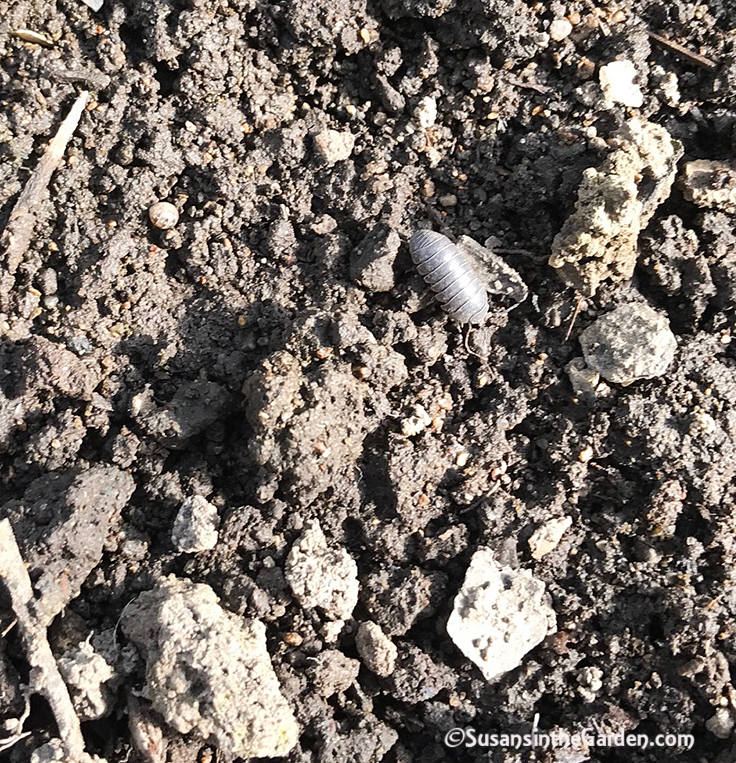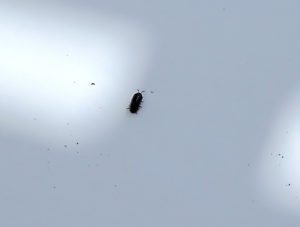Problems with pillbugs

I love learning new things, but I’m not so happy to learn the following tidbit. Pillbugs aren’t quite as benevolent as they’d like us to believe. Darn.
For years, I’ve known that pillbugs are benign critters that primarily feed on decomposing organic matter. So they play a useful role in building soil fertility. However, I now know there’s a Dr. Jekyll side to them that gardeners should be aware of.
I have a hoop house that I use for growing cold-tolerant veggies during the colder months of the year. In the spring, I use it for growing the heat-loving crops of cantaloupes and cucumbers.
About three weeks ago, I planted the seedlings that I’d started indoors two weeks before that. The seedlings were looking great (see above photo) and were fine for a couple of weeks. Then, I started noticing that some of them were kind of flopped over and also looking a bit pale.
Upon closer examination, I could see that something had been gnawing on the stems of the plants. Of course, being the slug-hater that I am, I immediately blamed the damage on slugs. After all, it did kind of look like slug damage.
I decided to sprinkle a bit of organic slug bait on the surface of the bed and then waited. The damage continued. I put empty tuna cans in the bed and filling them with cheap beer. As most folks know, slugs love beer, fall in and drown.
The following morning, I excitedly hurried out to the garden, expecting to see drowned slugs. Nope. That evening, I went back out to the garden with a flashlight to see if I could spot the culprit(s). Yup.
I immediately saw a pillbug crawling on the stem of one of the melon plants. Pillbugs?!! Still dubious that it could be the guilty party, I knocked it off the plant. Then I headed indoors to do some research. First of all, pillbugs do aid in plant matter decomposition. But they have been known to chew on the stems of particularly succulent stems.
If you’ve ever looked at the stems of melons, cucumbers, squash or pumpkins, you know they are indeed succulent. Darn!
So I headed back out to the garden once again, flashlight in hand. But this time, I went out with a bag of diatomaceous earth. I’ve written about this natural product before but let me provide a brief explanation. It’s a flour-like substance made from the fossilized remains of diatoms (algae). It’s harmless to us, but don’t breathe in the dust. However, it has tiny, sharp edges that cut into the skin of certain types of insects. Most notably, slugs, cutworms, ants, and earwigs. As a result of those cuts in their armor, they dehydrate and die.
I believe diatomaceous earth will work against pillbugs. Or perhaps it will provide the plants with a bit of a stronger defense against those stem-nibblers. What I did was sprinkle it around the base of the stems, and up on the stems a bit, too. That was a week ago and I haven’t noticed any more damage. Hooray!
The great thing is that as the seedlings grow a bit, they won’t be so tender and delicious. That means this will be a short-lived problem. But you’d better believe I went to my other beds containing summer and winter squash, and sprinkled diatomaceous earth around their stems as well!
So, I’ve now learned something new and felt I should pass it along to you. That’s just in case you’re experiencing the same problem. One last thing: am I recommending that you go out to your garden and kill the pillbugs? Absolutely not! While I’m discouraged about the damage they have done, I do remember the good they do in the garden, too.


